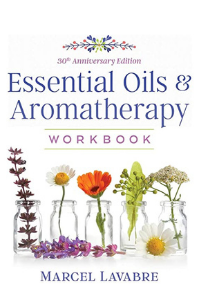
The Essential Oils & Aromatherapy Workbook: 30th Anniversary Edition, by Michael Lavabre
Healing Arts Press, ISBN: 1644110709, 256 pages, 2020
Many years ago, I’d studied aromatherapy under the guidance of a master-teacher. Though I never turned my studies into a professional craft, I have never not had essential oils on hand to make quick, handy blends since then.
For those not familiar, essential oils are distilled from aromatic plants in a steam distiller. They are equivalent to “lymph” in the human body — a liquid substance that flows between cell walls and aids the plant in cellular repair. They contain the plant’s chemical composition in an extremely concentrated form and are therefore used as a healing medicine with the glorious side benefit of exquisite aroma.

When I selected The Essential Oils & Aromatherapy Workbook, I thought, “Oh great, some new aromatherapy blend recipes to try.” Little did I know I was in for so much more. The author, Michael Lavabre, it turns out has been involved in the aromatherapy industry since the 1950’s when he was raised on a lavender farm in France. As an adult, he was one of the first practitioners of aromatherapy to introduce the craft in the United States. For in Europe and other parts of the world, it is extremely common for doctors and hospitals to use essential oils in their healing regimen for patients – that’s how powerful and effective they can be. In the United States, the craft of aromatherapy is more commonly associated with the beauty-wellness-New Age world and not mainstream medicine at all.
I write all of this because the book carefully documents the history of the development of the aromatherapy industry and its applications. In fact, this book gets quite technical into the medical applications of essential oils and how they are assimilated into the body as healing nutrients. The first half of the book is science-heavy, and I appreciated that. Though Lavabre doesn’t shy away from the spiritual effects of applying essential oils either, talking about morphogenetic fields and “action of essential oils on the spiritual plane.” 1
All of this comes before Lavabre talks about what each of the oils are and what they blend well with (the real reason I picked up this book!). For this, he offers a thorough encyclopedic reference with many lists, charts, and groupings. The most useful information for me is in Chapter 9, where Lavabre offers an alphabetically organized catalog of available essentials oils grouped according to their “Botanical Families.” For example, Lavabre lists the Apiaceae group, or “plants of the air element.” 2 This group includes angelica, carrot and fennel. Then in Chapter 10, he talks about “aromatic choreography,” which is the art of blending oils according the scent combinations. Here Lavabre even includes chromatography scans of the oils to demonstrate the complexity of the “aroma notes.”
In short, this colorful, straight-forward, and easy-to-read book supplies its reader with EVERYTHING you would ever need to know about the craft and the science of aromatherapy. The Essential Oils & Aromatherapy Workbook a must-read for any eager beginner and wonderful reference companion for a seasoned practitioner.
Carter is a professional Astrologer and founder of Success in the Stars Astrology. She has her Master of Divinity (MDiv) degree from Emory University with certificates in Women in Theology and Ministry, Clinical Pastoral Counseling, Motivational Interviewing, and Compassionate Communication. Carter received the Zen Buddhist Jukai ordination from Roshi Joan Halifax at Upaya Zen Center and is a 2nd Degree Reiki practitioner.
